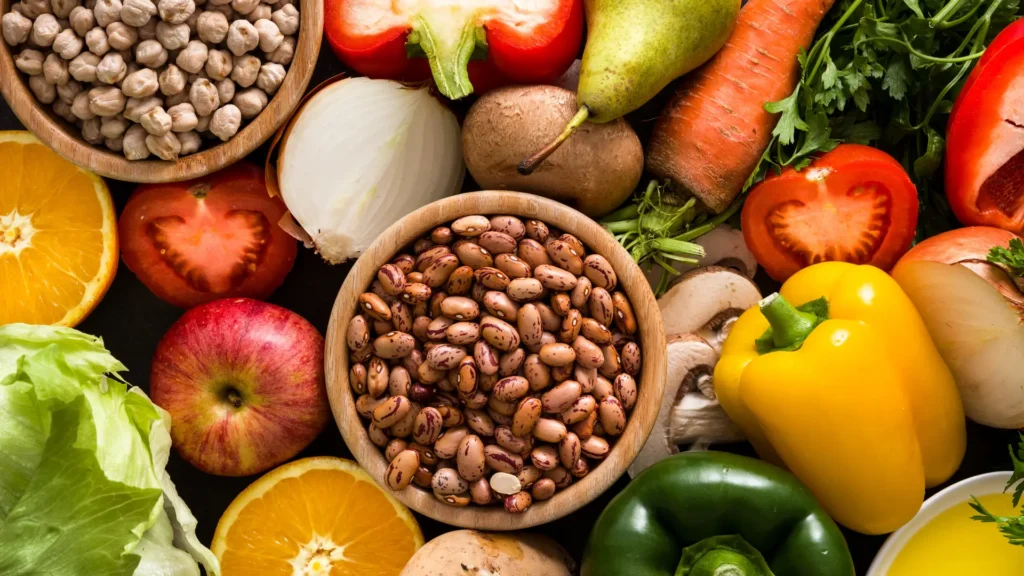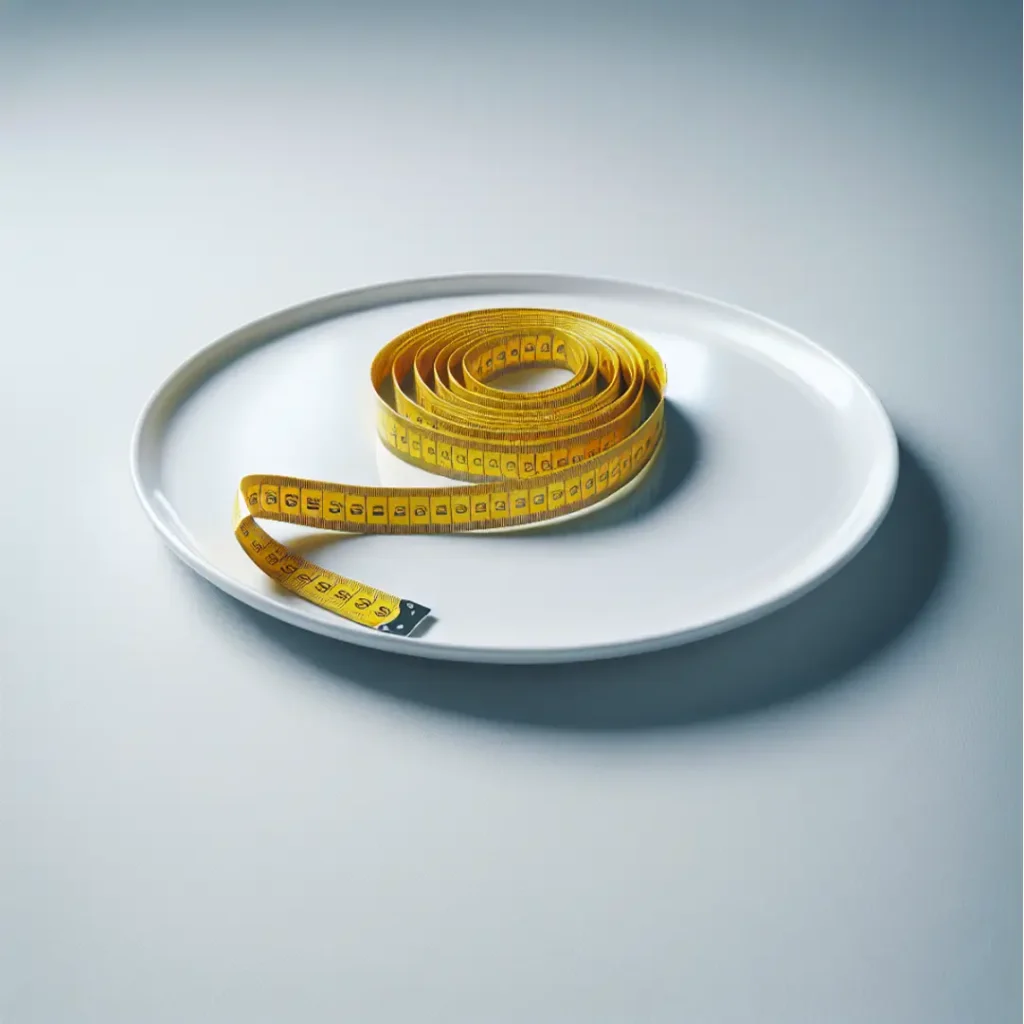Ever wondered how to eat to lose weight? It may seem counterintuitive, but the food you consume plays a pivotal role in your weight loss journey. The key lies in making mindful, informed choices about your diet. While exercise is crucial, a balanced and nutritious diet can significantly expedite your weight loss goals.
In this article, we delve into seven easy and effective steps that can be incorporated into your daily routine:
- Understand Your Body’s Needs
- Start Your Day with a Healthy and Filling Breakfast
- Opt for Frequent, Smaller Meals and Smart Snacks
- Prioritize Fiber-Rich Foods in Your Diet
- Choose Nutrient-Dense Options for Maximum Health Benefits
- Practice Portion Control and Mindful Eating
- Hydrate Well and Ditch Sugary Beverages
Each step is designed to guide you towards a healthier lifestyle and aid in sustainable weight loss. Ready to embark on this journey? Let’s dive right in!
Step 1: Understand Your Body’s Needs

We all have unique bodies, so it’s no surprise that our dietary needs differ too. To set yourself on the right path towards weight loss, you’ll need to identify how many calories your body requires daily. Understand that this is not about obsessing over every calorie consumed but about developing a clear understanding of your body’s energy needs.
Your Daily Energy Requirement
Your daily energy requirement is the number of calories your body needs to perform essential functions and physical activities. You can calculate this using factors like height, weight, age, gender, and activity level.
Here’s a simple way to estimate your daily caloric needs:
- Calculate your Basal Metabolic Rate (BMR): This is the number of calories your body needs to perform basic functions like breathing and circulation. Here is an example of a BMR Calculator.
- Factor in physical activity: Multiply your BMR by an activity factor:
- 1.2 for sedentary lifestyle
- 1.375 for light exercise
- 1.55 for moderate exercise
- 1.725 for heavy exercise
- Adjust for weight loss: Subtract around 500-1000 calories from the total to create a calorie deficit that supports weight loss.
For instance, the average recommended daily calorie intake is around 2,200 kcal for men and 1,800 kcal for women aiming to maintain their weight.
Remember that these figures are estimates — everyone’s metabolism is different and these calculations should serve as a starting point. Therefore, adjust as necessary based on weight loss progress and feelings of hunger or fullness.
Thus, knowing how much fuel your body truly needs can empower you to make informed choices about what you eat and when you eat it. This knowledge sets the stage for all other steps in your weight loss journey.
Step 2: Start Your Day with a Healthy and Filling Breakfast

Embarking on your weight loss journey doesn’t mean you have to sacrifice the most important meal of the day. A wholesome breakfast sets the tone for your dietary choices, providing the energy to kick start your metabolism and sustain you through the morning. Integrating protein into your breakfast is particularly effective for weight management. Here’s why:
How Protein Helps with Weight Loss
Protein intake first thing in the morning can significantly influence how full you feel throughout the day. It’s not just about calories; it’s about how those calories are used by your body.
Protein has the highest thermic effect, which means it requires more energy to metabolize compared to fats and carbohydrates.
Therefore. this not only helps in burning more calories but also plays a crucial role in building and repairing muscles, especially if you incorporate exercise into your weight loss plan.
When it comes to controlling appetite, protein is a powerhouse. It does this by affecting various hunger hormones, one of which is ghrelin.
Often referred to as the hunger hormone, ghrelin levels rise and fall throughout the day, signaling hunger and fullness respectively.
A protein-rich breakfast has been shown to reduce ghrelin levels more effectively than a carbohydrate-heavy start, leading to a decreased appetite and preventing overeating later in the day.
Protein-Packed Breakfast Ideas
Here are some good sources of protein that can easily be incorporated into breakfast options:
- Eggs: Versatile and packed with high-quality protein
- Greek Yogurt: Offers double the protein of regular yogurt
- Cottage Cheese: Low in fat and high in casein, a slow-digesting dairy protein
- Nuts and Seeds: Provide not only protein but also healthy fats
- Oatmeal: When topped with milk or a scoop of whey protein, becomes a well-rounded meal
- Smoothies: Combine fruits with milk or plant-based alternatives, adding nut butter or protein powder for an extra boost
By choosing these protein-packed foods for breakfast, you lay a foundation for controlled eating patterns during the rest of your day. Remember, it’s not just about reducing caloric intake but making strategic choices that promote satiety and metabolic health.
Step 3: Opt for Frequent, Smaller Meals and Smart Snacks

Eating small meals throughout the day can keep your metabolism active and help prevent intense hunger that leads to overeating. When you eat fewer calories more often, your blood sugar levels stay stable, which reduces cravings and improves energy levels.
Tips for Avoiding Overeating:
- Set Meal Timings: Plan out meal times and stick to them. Waiting too long between meals can lead to excessive hunger and larger portions.
- Pre-Measured Servings: Use smaller plates or bowls to naturally reduce portion sizes.
- Mindful Eating: Take your time with each bite and listen to your body’s hunger cues.
Healthy snacks are important allies in maintaining consistent energy intake. They bridge the gap between meals, keeping your metabolism active while providing an opportunity to include more nutrient-rich foods in your diet.
Healthier Snacking Options:
- Fresh Fruits and Vegetables: Nature’s fast food, they’re rich in fiber and water, helping you feel full.
- Nuts and Seeds: A handful provides protein and healthy fats that can satisfy hunger.
- Low-fat Dairy or Plant Milks: Yogurt or almond milk can offer a mix of protein and carbohydrates without excessive calories.
By incorporating smaller meals and smart snacking into your routine, you create a manageable eating pattern that supports weight loss without leaving you feeling deprived.
Related: Breakfast, Lunch & Dinner: Fantastic 100 Calorie Cutting Made Easy
Step 4: Prioritize Fiber-Rich Foods in Your Diet

Dietary fiber stands out in the nutrition world for its unique ability to aid weight loss by promoting a feeling of fullness. Unlike other food components, fiber resists digestion, allowing it to travel through the digestive tract slowly, which helps you feel satisfied longer after eating.
Benefits of Fiber Intake for Weight Loss:
- Promotes Satiety: Fiber expands in the stomach, triggering receptors that tell your brain you’re full.
- Slows Digestion: This process helps manage blood sugar levels by slowing down the absorption of sugars, preventing spikes in hunger.
- Assists Digestive Health: Fiber contributes to a healthy digestive system, reducing the likelihood of constipation and associated bloating.
Incorporating high-fiber foods into your diet is simple and delicious. Here are some top choices:
- Legumes: Beans, lentils, and chickpeas are not only rich in fiber but also pack a protein punch.
- Whole Grains: Opt for quinoa, barley, and whole grain breads over refined grains.
- Fruits and Vegetables: Berries, apples with skin, broccoli, and leafy greens offer a nutrient-dense source of fiber.
- Nuts and Seeds: Almonds, chia seeds, and flaxseeds are great for on-the-go snacking or as toppings.
By favoring these foods, you’ll not only enhance your fiber intake but also enrich your diet with essential vitamins and minerals. This approach leads to effective weight management without feeling deprived or battling constant hunger pangs.
As you integrate more fiber into your meals, remember to increase water consumption; fiber works best when adequately hydrated.
Step 5: Choose Nutrient-Dense Options for Maximum Health Benefits

What exactly are “nutrient-dense foods?” Simply put, these are foods that are high in nutrients but relatively low in calories. They contain vitamins, minerals, complex carbohydrates, lean protein, and healthy fats. Opting for nutrient-dense foods is a smart strategy in any weight loss diet because they provide essential nutrients without the extra calories.
So why are nutrient-dense foods so important for weight loss? Consider this – you could eat a small bag of chips or an apple for roughly the same number of calories. Which one will leave you feeling fuller and more satisfied? The apple wins out because it offers fiber and other nutrients that the chips lack. Nutrient-dense foods can help keep you full, reducing the likelihood of overeating or succumbing to cravings.
Now that we understand the concept, let’s look at some examples of nutrient-dense foods:
- Fruits and Vegetables: All varieties have different vitamins and minerals, so aim for a colorful mix.
- Whole Grains: Foods like brown rice, oatmeal, and whole grain bread are packed with fiber.
- Lean Protein: Sources such as chicken breast, turkey, fish, eggs, tofu.
- Legumes: Beans, lentils, chickpeas offer both protein and fiber.
- Nuts and Seeds: High in healthy fats and protein.
Remember to incorporate these into your daily diet to make the most of their weight loss benefits.
Step 6: Practice Portion Control and Mindful Eating

Managing portion sizes can significantly impact your calorie intake. It’s easy to underestimate the amount of food you’re consuming, especially when dining out or eating pre-packaged meals. Portion control techniques can help keep your calorie count in check.
Portion Control Techniques
Here are some strategies to help you practice portion control:
- Use Smaller Plates and Bowls: Research shows that people tend to eat less when they use smaller dishware.
- Read Food Labels: Understanding serving sizes on food labels can help you judge appropriate portions.
- Measure and Weigh Food: Until you’re familiar with portion sizes, using measuring cups or a food scale can ensure accuracy.
The Importance of Mindful Eating
But what about the experience of eating? Here enters the concept of mindful eating practices. Mindfulness is about being present in the moment and paying close attention to experiences. When applied to eating, it helps prevent overeating and increases satisfaction from meals.
To practice mindful eating, try these tips:
- Eat Slowly: It takes about 20 minutes for your brain to register that you’re full.
- Eliminate Distractions: Eating without distractions (like TV or smartphones) allows you to focus on your meal and recognize physical hunger and fullness cues.
- Appreciate Your Food: Take time to savor the taste, texture, and aroma of your meals.
By combining portion control techniques with mindful eating habits, you can manage portions effectively and enjoy every bite without overeating. Additionally, this dual strategy not only supports weight loss but also fosters a healthier relationship with food.
Find out about Healthy Plate and how to manage your portions.
Step 7: Hydrate Well and Ditch Sugary Beverages

Hydration is important for managing weight. Drinking enough water helps with metabolism, digestion, and absorbing nutrients. It can also make you feel fuller and less likely to snack unnecessarily.
Tips for Staying Hydrated:
- Keep a water bottle nearby throughout the day.
- Add fruits or herbs to your water for flavor.
- Eat foods with high water content like cucumbers and watermelon.
On the other hand, sugary drinks can hinder your weight loss progress. They are high in calories but low in nutrients, which can lead to weight gain if consumed regularly.
Did you know? A single can of soda has as much as 10 teaspoons of added sugar!
Choosing healthier options can make a big difference in reducing your calorie intake:
- Drink unsweetened teas or infused water instead of sodas.
- Order Kopi Siew Dai or Teh Siew Dai next time you’re at the hawker centre.
- Make your own smoothies using whole fruits and vegetables without adding extra sugars.
Remember, it’s not just about cutting calories but also about giving your body the right nutrients it needs. So let’s start hydrating wisely and say goodbye to sugary drinks!
Related: The Best Refreshment: Staying Hydrated for Optimal Wellness
Maintaining a Long-Term, Sustainable Approach to Eating for Weight Loss

Embarking on a journey to Eat to Lose Weight isn’t just about shedding pounds; it’s about embracing a lifestyle that promotes health and well-being. The allure of quick fixes is strong, but the true essence of weight management lies in consistency and balance.
Embracing a Sustainable Approach
Adopting a sustainable approach means integrating the habits that support weight loss into your daily life. It’s about making choices that you can stick with over time, not just until you reach your goal weight. This commitment to a healthy way of living ensures that the results you achieve are not fleeting, but lasting.
Consider these key strategies for sustainable weight loss:
- Variety is the Spice of Life: Incorporate diverse foods into your diet to keep meals interesting and nutritious.
- Listen to Your Body: Pay attention to hunger cues and fullness signals rather than eating by the clock.
- Set Realistic Goals: Aim for progress, not perfection. Small, achievable milestones lead to greater long-term success.
- Stay Active: Find physical activities you enjoy and make them part of your routine.
The Journey Towards Better Health
Sustainable weight loss is a marathon, not a sprint. It requires patience, perseverance, and self-compassion as you navigate the path towards better health. Thus, by adopting these principles into your lifestyle, you create a foundation for lasting change.


